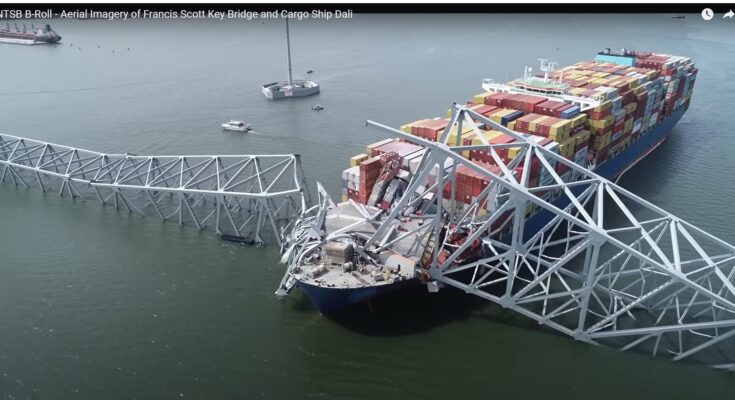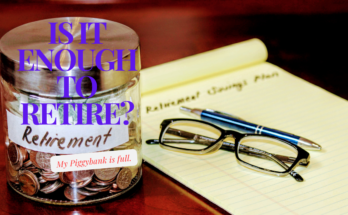What Do We Know About the Collapse?
Early on the morning of March 26, 2024, at 01:27 EDT, the Singaporean-flagged ship Dali, en route from the port of Baltimore to Colombo, Sri Lanka, was traveling at 8 knots (about 9 mph or 15 kph) when it struck one of the support pillars of the Francis Scott Key Bridge. The impact caused the bridge to break apart in several places and collapse into the Patapsco River.
According to the Baltimore Fire Chief, as reported by the Associated Press (AP), at least seven vehicles fell into the river, along with eight construction workers who were on the bridge at the time. Two workers were rescued from the water, one in critical condition, while the remaining six were initially reported missing and later confirmed dead.
Shortly after leaving the port of Baltimore, the crew of the Dali notified the Maryland Department of Transportation that the vessel had lost power, resulting in a loss of propulsion. Authorities used the term “allision” to describe the strike of a stationary object, as opposed to “collision,” which refers to the impact between moving objects. A mayday was issued, and traffic on the bridge was halted.
The National Transportation Safety Board (NTSB) confirmed via Twitter (@NTSB_newsroom) on March 26, 2024, that a team of experts had been dispatched to investigate the accident. The Federal Bureau of Investigation (FBI) also confirmed that terrorism was not the cause of the collapse.
Later that day, an AP news report revealed that Grace Ocean, the maritime company that owns the Dali, had been recently cited for labor violations. Additionally, data from the EQUASIS website (which tracks maritime transport data) indicated that a June inspection in a Chilean port had identified issues with the vessel’s propulsion system and other auxiliary machines. However, a subsequent inspection by the US Coast Guard in New York in September found no deficiencies.
What Is the Economic Impact of the Collapse?
According to the Wall Street Journal, the port of Baltimore was the ninth largest in the US by trade volume in 2023, handling around 50 million tons of cargo from international trade. As a major international shipping hub on the East Coast, the port facilitates the movement of massive cargo vessels via the Chesapeake Bay to the Atlantic Ocean.
The loss of the bridge will impede longshoremen and other dockworkers in their daily commutes, potentially causing shipping delays and other logistical problems due to the wreckage in the waterway. Moreover, the NTSB revealed that 56 containers from the Dali contain hazardous, corrosive, and flammable materials, although no significant environmental threats or air pollution have been reported thus far.
Maritime experts contacted by the AP suggested that although the Baltimore port is crucial for the import and export of farm equipment, automobiles, and light trucks, the collapse will not have a significant impact on worldwide trade. However, Reuters reported that losing the port will temporarily hamper the movement of cargo.
Authorities have revealed that 40 ships, including cargo vessels, tugboats, and cruise ships, remain trapped at the port since the collapse. The governor’s office has warned that nearly 140,000 jobs linked to the port could be at risk.
The economic effects will be more localized. According to data from the Baltimore Banner, around 35,000 people used the Francis Scott Key Bridge daily. Commuters could be out of work if they cannot find alternative routes. Some experts have warned that economic disruption could last at least a year. When the I-35W Mississippi River Bridge collapsed in 2007 in Minneapolis, it took nearly a year to construct a new one, despite being one-third the length of the Francis Scott Key Bridge. Although President Biden has promised $60 million in emergency funding, the road to recovery in the region could be much longer.
The Crumbling State of US Infrastructure
According to a 2018 report by the World Association for Waterborne Transport Infrastructure (WAWTI), between 1960 and 2015, thirty-five major bridge collapses worldwide were due to ship or barge impacts, with over 50% occurring in the US. These statistics highlight a serious problem in the US maritime industry, potentially due to crumbling or inadequate infrastructure, lack of or outdated training, and other factors.
For years, states and cities have neglected infrastructure investment. The World Economic Forum (WEF) ranked the US 13th among advanced economies in infrastructure quality. The Center on Budget and Policy Priorities (CBPP) reported that infrastructure investment by state and local governments declined from 3% of GDP in 1960 to below 2% half a century later.
The state of America’s infrastructure is dire. The $1 trillion bipartisan Infrastructure Investment and Jobs Act, signed into law on November 15, 2021, aimed to address the problem. However, more than two years later, the positive economic impact has yet to be felt, with some results contributing to inflation and rising national debt.
The delay in needed infrastructure investments may ultimately cost the US economy dearly. This postponement and sudden urgency could be a classic case of “too little, too late,” where the cure is more dangerous than the disease.
Conclusion
The collapse of the Francis Scott Key Bridge is a stark reminder of the vulnerabilities within our nation’s infrastructure. The tragic loss of lives and the significant disruption to the local economy highlight the dire consequences of neglected maintenance and inadequate investment. As a critical transportation link for the port of Baltimore, the bridge’s failure has profound implications, not only for local commuters and workers but also for the broader logistical and economic systems that depend on this vital connection.
This incident underscores the urgent need for comprehensive infrastructure investment and modernization. The findings of the investigation, including the role of the Dali’s mechanical failures and the broader context of infrastructural neglect, must serve as a catalyst for action. Immediate steps must be taken to ensure the safety and reliability of existing infrastructure, alongside long-term strategies to rebuild and modernize our transportation networks.
The bipartisan Infrastructure Investment and Jobs Act is a step in the right direction, but its impact must be felt on the ground, preventing future tragedies and supporting economic resilience. The path forward requires not only financial investment but also a commitment to rigorous safety standards, proactive maintenance, and innovative solutions to meet the demands of the 21st century.
As we mourn the lives lost and address the immediate challenges posed by this disaster, let it also serve as a clarion call to prioritize infrastructure as a matter of national importance. By doing so, we can safeguard our communities, support economic growth, and prevent such devastating incidents in the future.
The featured picture: Francis Scott Key Bridge and Cargo Ship Daly. File Retrieved from https:// www.youtube.com/@NTSBgov




